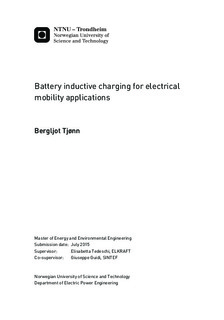Battery inductive charging for electrical mobility applications
Master thesis
Date
2015Metadata
Show full item recordCollections
- Institutt for elkraftteknikk [2468]
Abstract
This report is a master thesis at the Department of Electrical Engineering at the Norwegian University of Science and Technology (NTNU). The purpose of the thesis was to find a control system used for regulating a system for inductive charging of electric ferries.
Systems for inductive power transfer can be utilized in wireless charging of electric mobility applications. Wireless charging of electric mobility applications is especially advantageous for methods of public transportation that make short, but frequent stops, as buses and ferries. In this thesis, a system for inductive charging of electric ferries will be examined, with system design and specifications provided by SINTEF.
The system is described and simplified in order to derive a transfer functionthat is simplified using dominant pole approximation. The resulting simplification is a second order transfer function of the form H(s) = a0/(s^2 + b1s + b0) with the terms a0, b1 and b0 varying according to the distance between the sending and receiving coils. Two scenarios for distance between the coils is looked into: A maximum distance, leading to a low coupling coefficient k for the system, and a minimum distance, leading to a high coupling coefficient for the system. For these cases of coupling two methods for controller design are looked into: Haalman s loop shaping technique and experimental tuning by tuning maps. Based on these methods two controllers withconstant gains are designed.
The two methods lead to two controllers: One integral-only controller and one PID-controller in series with a filter. The systems responses with the two controllers is evaluated and compared, and it is concluded that theintegral-only controller is the best choice for controlling the system.
